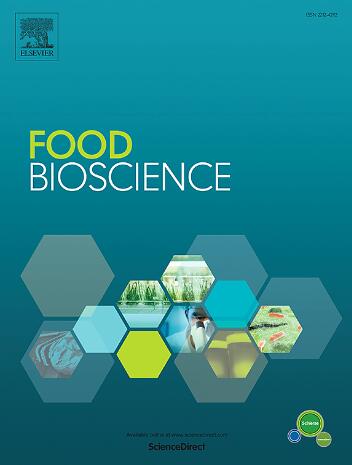l -天冬氨酸-α-脱羧酶的结构导向工程,以提高底物耐受性和β-丙氨酸产量
IF 5.9
1区 农林科学
Q1 FOOD SCIENCE & TECHNOLOGY
引用次数: 0
摘要
β-丙氨酸是食品添加剂、药物和含氮化合物的重要前体,其生物合成主要由l -天冬氨酸-α-脱羧酶(PanD)催化。然而,野生型PanD的固有局限性,包括低催化效率和高浓度下明显的底物抑制,极大地限制了其工业应用。本研究系统比较了三种PanD同源物(大肠杆菌EcPanD、谷氨酰胺棒状杆菌CgPanD和枯草芽孢杆菌BsPanD),揭示了BsPanD优越的催化效率。BsPanD在高L-天冬氨酸浓度下表现出底物抑制作用,在60 g/L和100 g/L底物下转化率分别为78%和52%。通过蛋白结构的构建和合理的面向结构设计,以及计算筛选和实验验证,我们从40个候选突变体中筛选出耐受性显著提高的5个突变体(BsPanDT4W、bspdi33a、BsPanDP40N、bspdi88w、BsPanDN109E)。这些突变体在60 g/L底物下的转化率达到90.6 - 92.9%,产生36.4-37.4 g/L β-丙氨酸。此外,动力学分析表明,所有突变体的Km值都降低了(降低28 - 45%),表明底物亲和力增强。值得注意的是,BsPanDI33A表现出最高的催化效率(kcat/Km = 1.95 s−1 mmol−1 L,比野生型增加57.3%),这归因于Ile33Ala突变减少了空间位阻。凭借其在高底物浓度(60 g/L转化率为92.9%)和优化的催化效率,BsPanDI33A成为最有前途的工业β-丙氨酸生产生物催化剂。这些结果为PanD催化提供了新的见解,并建立了一个强大的工业β-丙氨酸生物合成平台。本文章由计算机程序翻译,如有差异,请以英文原文为准。
Structure-guided engineering of L-aspartate-α-decarboxylase for enhanced substrate tolerance and β-alanine yield
β-Alanine is an important precursor for food additives, drugs, and nitrogen-containing compounds, and its biosynthesis is mainly catalyzed by L-aspartate-α-decarboxylase (PanD). However, the inherent limitations of wild-type PanD, including low catalytic efficiency and pronounced substrate inhibition at high concentrations, significantly constrain its industrial applications. This study systematically compared three PanD orthologs (EcPanD from Escherichia coli, CgPanD from Corynebacterium glutamicum, and BsPanD from Bacillus subtilis), revealing BsPanD's superior catalytic efficiency. BsPanD exhibited substrate inhibition at high L-aspartate concentrations, with conversion rates of 78 % and 52 % at 60 g/L and 100 g/L substrate, respectively. Through the construction of protein structures and reasonable structure-oriented design, as well as computational screening and experimental verification, we selected five mutants (BsPanDT4W, BsPanDI33A, BsPanDP40N, BsPanDI88W, BsPanDN109E) with significantly improved tolerance from 40 candidate mutants. These mutants achieved 90.6–92.9 % conversion rates at 60 g/L substrate, yielding 36.4–37.4 g/L β-alanine. In addition, kinetic analyses demonstrated reduced Km values (28–45 % decrease) in all mutants, indicating enhanced substrate affinity. Notably, BsPanDI33A exhibited the highest catalytic efficiency (kcat/Km = 1.95 s−1 mmol−1 L, a 57.3 % increase over the wild-type), attributed to reduced steric hindrance from the Ile33Ala mutation. With its exceptional performance at high substrate concentration (92.9 % conversion at 60 g/L) and optimized catalytic efficiency, BsPanDI33A emerges as the most promising biocatalyst for industrial β-alanine production. These results provide novel insights into PanD catalysis and establish a robust platform for industrial β-alanine biosynthesis.
求助全文
通过发布文献求助,成功后即可免费获取论文全文。
去求助
来源期刊

Food Bioscience
Biochemistry, Genetics and Molecular Biology-Biochemistry
CiteScore
6.40
自引率
5.80%
发文量
671
审稿时长
27 days
期刊介绍:
Food Bioscience is a peer-reviewed journal that aims to provide a forum for recent developments in the field of bio-related food research. The journal focuses on both fundamental and applied research worldwide, with special attention to ethnic and cultural aspects of food bioresearch.
 求助内容:
求助内容: 应助结果提醒方式:
应助结果提醒方式:


